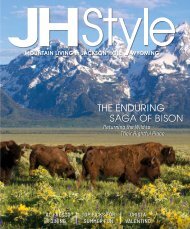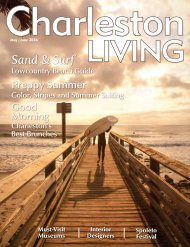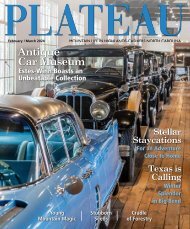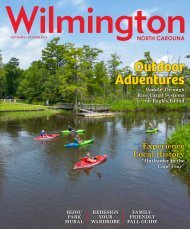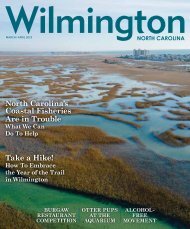Charleston Living Magazine Nov-Dec 2023
Charleston SC - The official city magazine for Charleston SC since 2012. Charleston Living Magazine is the authority on living the good life in Charleston, Mount Pleasant, Summerville, Isle of Palms, Sullivan's Island and Folly Beach, SC, showcasing homes and design, restaurants, art, fashion, business and more.
Charleston SC - The official city magazine for Charleston SC since 2012. Charleston Living Magazine is the authority on living the good life in Charleston, Mount Pleasant, Summerville, Isle of Palms, Sullivan's Island and Folly Beach, SC, showcasing homes and design, restaurants, art, fashion, business and more.
You also want an ePaper? Increase the reach of your titles
YUMPU automatically turns print PDFs into web optimized ePapers that Google loves.
TRAVEL<br />
The hotel, which is named for both the number of rooms and<br />
the year of the eruption, feels grand but not flashy, with marble, wood<br />
and jewel-toned velvet in the public areas and lots of soothing blues<br />
and greens in the rooms. The hotel’s restaurant, Il Circolo, has become<br />
a hub for locals, who gather each morning for espresso and gossip at<br />
the bar. In the evening, dressed to the nines, they return for apertivo—<br />
which resembles a cocktail party—a late and, if there’s live music,<br />
dancing. It became clear that we were the only outsiders, but, before<br />
long, we’d been gathered into the friendly fold, where we did a bit of<br />
dancing ourselves and learned that dinner is just a small part of an<br />
Italian evening out. It’s fun, festive and, thanks to Executive Chef Roberto<br />
Lepre’s knack for lushly-sauced pastas, delicious. If you’re lucky,<br />
Chef will hold one of his casual cooking classes while you’re there;<br />
ours taught me that making gnocchi—tiny pasta dumplings shaped<br />
one-at-a-time around the tines of a fork—is best left to professionals.<br />
During the warmer months, the action moves to the rooftop, which<br />
offers gorgeous views of Mount Vesuvius.<br />
The hotel is also home to a Nuxe spa and it offers something quite<br />
rare: a hot stone massage with local volcanic stones. I wish I’d booked two.<br />
Since Pompeii’s ruins are the most-visited archaeological site in<br />
the world, I had expected a typical touristy town but instead I discovered<br />
a city that, once I got beyond the entrance to the ruins, was so traditional<br />
that shops still close during the middle of the day. It was lovely<br />
and refreshing to find myself immersed in authenticity as I wandered<br />
through the dusty hardware stores, beautiful fur and leather boutiques,<br />
shoe shops, butchers, fruit markets and decadent gelaterias along Via<br />
Lepanto. Pompeii’s ornate cathedral was consecrated in 1891; a highlight<br />
is the painting Our Lady of Pompeii, which was purchased for<br />
the equivalent of one dollar and transported from Naples to the church<br />
in a manure-filled wagon.<br />
I was surprised to learn that Vesuvius itself can be explored on<br />
foot via the Gran Cono trail. It takes about two hours to complete the<br />
110 | <strong>Charleston</strong><strong>Living</strong>Mag.com<br />
popular four-kilometer journey.<br />
I highly recommend hiring a guide to take you through the ruins.<br />
Though the signage is ample, and in English, it doesn’t convey the emotion<br />
that locals and historians still have for the place. I didn’t realize, for<br />
instance, that Pompeii was a bustling trade port (the eruption moved<br />
the coastline further west) that was home to about 20,000 residents.<br />
There were wine bars, restaurants, brothels and a huge amphitheater<br />
where gladiators trained. The guide shared brilliant innovations, too,<br />
like the stepping stones that stretched across streets so that pedestrians<br />
could cross without getting their feet wet when the roadways flooded.<br />
The raised stones were spaced so that chariots could pass over them<br />
without breaking an axel.<br />
Walking through the crowded streets of Pompeii, I had no trouble<br />
imagining the city as a lively metropolis where people lived, played,<br />
loved ate and schemed. Within the praedia—or inn—owned by a<br />
woman named Julia Felix, I discovered ornate gardens, deep soaking<br />
tubs and a spa with an outdoor pool. At the House of Vettii, which<br />
reopened to the public in early <strong>2023</strong>, I marveled at remarkably vibrant<br />
frescoes of angels, buildings and scenes of gruesome punishments<br />
framed by walls painted in deep shades of red and yellow.<br />
Tragically, it was also easy to imagine how these families had died:<br />
some skeletal remains lie in situ; there are also full-sized plaster casts<br />
fabricated by archaeologists more than two hundred years ago. The<br />
casts were made when scientists discovered that, long after the bodies<br />
of the victims had decomposed, the ash that had killed them retained<br />
the shape of their bodies. After pouring plaster into the voids and allowing<br />
it to harden, workers were left with life-sized statues of men,<br />
women and children that are remarkable in their detail.<br />
I’m glad I had several days to take in Pompeii. Not only was I<br />
able to stare at Vesuvius and wonder about the lives it had changed,<br />
but I was also able to explore the wonderfully unscripted city, all at<br />
my own pace. •<br />
PHOTOS HABITA 79



